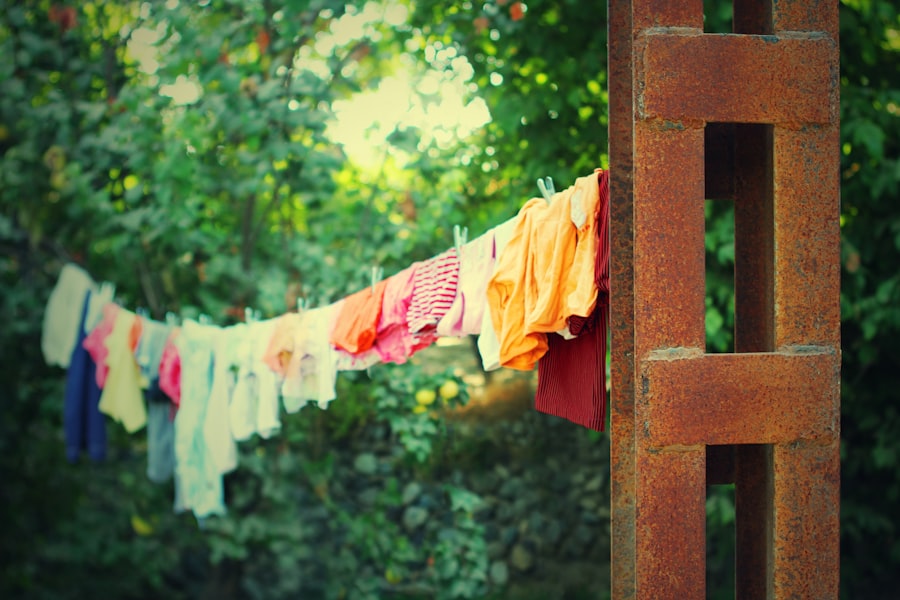The process of drying clothes is governed by several scientific principles, primarily involving heat transfer and moisture evaporation. When wet clothes are placed in a dryer, the heat generated causes the water molecules within the fabric to gain energy and transition from a liquid state to vapor. This vapor then needs to escape from the fabric and be expelled from the dryer.
The efficiency of this process can be influenced by various factors, including the type of fabric, the amount of moisture present, and the temperature settings used during drying. Moreover, the drying time can also be affected by the ambient conditions in which the drying takes place. For instance, higher humidity levels in the air can slow down the evaporation process, leading to longer drying times.
Conversely, lower humidity levels can facilitate quicker drying. Understanding these scientific principles can help individuals make informed decisions about how to optimize their drying processes, whether using a conventional dryer or opting for air drying methods.
Key Takeaways
- Understanding the Science Behind Drying Time: Knowing how air circulation and heat affect drying time can help you optimize your laundry routine.
- Utilizing High-Speed Spin Cycles: Using high-speed spin cycles in your washing machine can significantly reduce the moisture content in your clothes, leading to faster drying times.
- Choosing the Right Drying Setting: Selecting the appropriate drying setting based on the fabric type and load size can help prevent over-drying or under-drying.
- Using Dryer Balls or Tennis Balls: Adding dryer balls or tennis balls to the dryer can help fluff and separate clothes, reducing drying time and static cling.
- Hanging Clothes Strategically: Hanging clothes on a drying rack or hanger can help air circulate around them, speeding up the drying process.
Utilizing High-Speed Spin Cycles
One effective way to reduce drying time is by utilizing high-speed spin cycles in washing machines. These cycles are designed to extract as much water as possible from wet clothes before they even enter the dryer. By spinning at higher speeds, the washing machine can significantly decrease the moisture content of fabrics, which in turn shortens the time required for drying.
This not only saves energy but also helps preserve the quality of the garments by minimizing exposure to prolonged heat. In addition to saving time, high-speed spin cycles can also enhance the overall efficiency of laundry routines. For households with multiple loads of laundry, this feature can be particularly beneficial.
By ensuring that clothes come out of the wash with less water, individuals can reduce the number of drying cycles needed, leading to lower energy consumption and a more sustainable approach to laundry.
Choosing the Right Drying Setting

Selecting the appropriate drying setting on a dryer is crucial for optimizing drying time while also protecting clothing from damage. Most modern dryers come equipped with various settings tailored for different fabric types and moisture levels. For instance, using a high heat setting may be suitable for durable fabrics like towels and jeans, but it could cause delicate items such as silk or lace to shrink or become damaged.
Understanding fabric care labels is essential when choosing drying settings. These labels provide valuable information about the recommended drying temperatures and methods for each garment. By adhering to these guidelines, individuals can ensure that their clothes dry efficiently without compromising their integrity.
Additionally, many dryers now feature moisture sensors that automatically adjust drying times based on how wet the clothes are, further enhancing efficiency and preventing over-drying.
Using Dryer Balls or Tennis Balls
| Comparison | Dryer Balls | Tennis Balls |
|---|---|---|
| Effectiveness | High | Medium |
| Noise Level | Low | High |
| Durability | High | Low |
| Cost | Medium | Low |
Incorporating dryer balls or even tennis balls into the drying process can significantly improve drying efficiency. These items work by creating space between garments as they tumble in the dryer, allowing hot air to circulate more freely around each piece of clothing. This increased airflow helps to evaporate moisture more quickly, ultimately reducing overall drying time.
Furthermore, dryer balls can also help to soften fabrics naturally without the need for chemical fabric softeners. They can reduce static cling and minimize wrinkles, making clothes come out looking fresher and feeling softer. Tennis balls serve a similar purpose and are often a cost-effective alternative for those looking to enhance their drying experience without investing in specialized products.
Hanging Clothes Strategically
For those who prefer air drying their clothes, hanging them strategically can make a significant difference in drying time. The placement of garments can affect how quickly they dry; for instance, spreading clothes out on a line or rack allows for better airflow around each item. This is particularly important in humid environments where moisture can linger in the air.
Additionally, individuals should consider hanging clothes in well-ventilated areas with ample sunlight exposure. Sunlight not only helps to evaporate moisture but also has natural antibacterial properties that can help keep clothes fresh. By taking advantage of natural elements like wind and sunlight, individuals can effectively reduce drying time while also being environmentally conscious.
Maximizing Airflow in the Drying Area

Creating an environment that maximizes airflow is essential for efficient drying, whether indoors or outdoors. In indoor settings, ensuring that windows are open or using fans can help circulate air and promote faster evaporation of moisture from clothes. This is particularly important during colder months when indoor humidity levels tend to rise due to heating systems.
Outdoor drying can also benefit from strategic placement. Hanging clothes in areas with good wind exposure will enhance airflow and speed up the drying process. Avoiding enclosed spaces where air cannot circulate freely will prevent dampness from lingering on fabrics and lead to fresher-smelling laundry.
Adding a Dry Towel to the Load
A simple yet effective trick to speed up drying time is adding a dry towel to the dryer load. The dry towel absorbs excess moisture from wet clothes, allowing them to dry more quickly. This method works particularly well when dealing with heavier fabrics like towels or blankets that tend to retain more water.
In addition to reducing drying time, this technique can also help prevent overloading the dryer with wet items, which can lead to uneven drying and longer cycles. By incorporating a dry towel into the load, individuals can achieve a more balanced distribution of moisture and ensure that all items come out dry and ready to wear.
Taking Advantage of Indoor Drying Options
Indoor drying options have become increasingly popular, especially in urban settings where outdoor space may be limited. Utilizing indoor drying racks or foldable clotheslines allows individuals to dry their laundry without relying solely on a dryer. These options are not only space-efficient but also environmentally friendly.
When using indoor drying methods, it is essential to choose locations that promote airflow and light exposure. Placing racks near windows or in well-ventilated rooms can significantly enhance drying efficiency. Additionally, using dehumidifiers in indoor spaces can help control humidity levels, further speeding up the drying process and preventing musty odors from developing on damp fabrics.
Using a Dehumidifier to Speed Up Drying
In areas with high humidity levels, using a dehumidifier can be an effective solution for speeding up the drying process. Dehumidifiers work by removing excess moisture from the air, creating an environment that is conducive to faster evaporation of water from wet clothes. This is particularly beneficial during rainy seasons or in coastal regions where humidity tends to be high.
By maintaining optimal humidity levels indoors, individuals can not only enhance their laundry drying experience but also improve overall air quality within their homes. A dehumidifier can help prevent mold growth on damp fabrics and reduce allergens in the air, contributing to a healthier living environment.
Avoiding Overloading the Dryer
One common mistake that many individuals make is overloading the dryer with too many items at once. While it may seem efficient to dry multiple loads simultaneously, overloading can lead to longer drying times and uneven results. When clothes are packed tightly together, hot air cannot circulate effectively, resulting in damp spots and extended cycles.
To ensure optimal performance from a dryer, it is advisable to follow manufacturer guidelines regarding load capacity. By allowing enough space for garments to tumble freely, individuals can achieve quicker drying times and better overall results. This practice not only saves energy but also prolongs the lifespan of both clothing and the dryer itself.
Embracing Quick-Dry Fabrics and Clothing Items
In today’s market, quick-dry fabrics have gained popularity due to their ability to wick moisture away from the body and dry rapidly after washing. These materials are often made from synthetic fibers designed specifically for efficient moisture management. Embracing quick-dry clothing items can significantly reduce laundry-related frustrations and enhance overall convenience.
Individuals who frequently engage in outdoor activities or sports may find quick-dry fabrics particularly beneficial. Not only do these materials dry faster than traditional cotton or wool, but they also tend to be lightweight and breathable, making them ideal for active lifestyles. By incorporating quick-dry items into their wardrobes, individuals can streamline their laundry routines while enjoying greater comfort during wear.
In conclusion, understanding various techniques and strategies for optimizing drying time can lead to more efficient laundry practices while preserving clothing quality. From utilizing high-speed spin cycles and selecting appropriate settings on dryers to embracing quick-dry fabrics and maximizing airflow in drying areas, individuals have numerous options at their disposal. By implementing these methods thoughtfully, they can enjoy fresher laundry with reduced energy consumption and enhanced convenience in their daily lives.
During rainy weeks, drying laundry can be a challenge, but there are several hacks to help cut down on drying time. One effective method is to use a dehumidifier in your laundry room, which can significantly reduce moisture in the air and speed up the drying process. Additionally, maximizing space in your home can also aid in more efficient laundry management. For those looking to optimize their storage solutions, consider reading this related article on how to build a custom closet organizer: How to Build a Custom Closet Organizer: A Step-by-Step Guide to Maximize Space and Style. This guide provides valuable insights into creating organized spaces that can help streamline your laundry routine.
FAQs
What are some laundry hacks to cut drying time during rainy weeks?
Some laundry hacks to cut drying time during rainy weeks include using a high-speed spin cycle on your washing machine, using dryer balls or clean tennis balls to help fluff and separate clothes in the dryer, and using a dry towel to help absorb excess moisture from the wet clothes.
How can I make my clothes dry faster during rainy weather?
To make your clothes dry faster during rainy weather, you can use a dehumidifier in the laundry room to help remove excess moisture from the air, hang clothes on a drying rack indoors, or use a portable clothing steamer to help remove wrinkles and moisture from clothes.
Are there any products that can help speed up the drying process during rainy weeks?
Yes, there are products that can help speed up the drying process during rainy weeks. Some of these products include dryer balls or clean tennis balls to help fluff and separate clothes in the dryer, a portable clothing steamer to help remove wrinkles and moisture from clothes, and a dehumidifier to help remove excess moisture from the air in the laundry room.
What are some tips for drying clothes indoors during rainy weather?
Some tips for drying clothes indoors during rainy weather include using a drying rack or clothesline indoors, using a dehumidifier to help remove excess moisture from the air, and using a portable clothing steamer to help remove wrinkles and moisture from clothes.






